Mari’s Blog
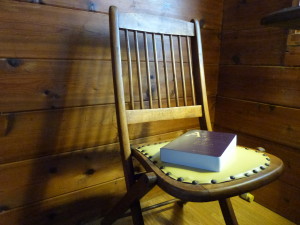
The indwelling, the birth, and the end of preparing
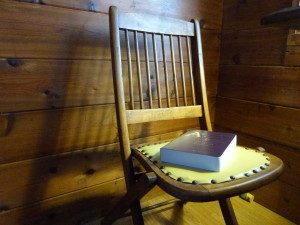 Help is here. Be what you have been called to be. Open your dwelling place to your true Self, your true identity. Imagine this opening and this replacement occurring with every fiber of your being. Imagine the separate self being enfolded, embraced, and finally consumed—taken into the Self of union. The body of Christ becomes real through this indwelling of Christ in form. D.Day1:11
Help is here. Be what you have been called to be. Open your dwelling place to your true Self, your true identity. Imagine this opening and this replacement occurring with every fiber of your being. Imagine the separate self being enfolded, embraced, and finally consumed—taken into the Self of union. The body of Christ becomes real through this indwelling of Christ in form. D.Day1:11
Yesterday morning I’m on the internet trying to find the plants we all had back in the 70s—big-  leafed plants that grew in hanging pots held in macramé plant holders. I thought they were called Elephant Ears, but looking them up by that name I was unable to find any that looked like those I remembered. So I ask Google, “What were those plants from the 70’s that everyone had hanging in macramé plant holders?” Not surprisingly, I get mixed results. I am given a link to a company, called Macramé Magic, a place that designs and sells plant hangers—which makes sense. Then “Stealing Fatima’s Hand,” a book by Carolyn Thériault on her experiences in Rabat. Then cook books, one for enchiladas and another for barbecue. Then another book, “A Voyage Through the New Testament,” by Catherine Cory, and finally a book on confidence by Barbara De Angeles. The bazaarness of this mix catches my interest, like a bit of silliness has entered my day, and I read a little about each. A quote highlighted on De Angeles’ book cover stays with me when I walk away, defeated in my search for the hippie plant:
leafed plants that grew in hanging pots held in macramé plant holders. I thought they were called Elephant Ears, but looking them up by that name I was unable to find any that looked like those I remembered. So I ask Google, “What were those plants from the 70’s that everyone had hanging in macramé plant holders?” Not surprisingly, I get mixed results. I am given a link to a company, called Macramé Magic, a place that designs and sells plant hangers—which makes sense. Then “Stealing Fatima’s Hand,” a book by Carolyn Thériault on her experiences in Rabat. Then cook books, one for enchiladas and another for barbecue. Then another book, “A Voyage Through the New Testament,” by Catherine Cory, and finally a book on confidence by Barbara De Angeles. The bazaarness of this mix catches my interest, like a bit of silliness has entered my day, and I read a little about each. A quote highlighted on De Angeles’ book cover stays with me when I walk away, defeated in my search for the hippie plant:
“When you base your confidence on who you are instead of what you can accomplish, you have created something that no one and no circumstance can ever take away from you.”
 All of a sudden I was deeply into this idea, feeling it running through me and mingling with similar ideas from A Course of Love. It was there in the background as I did my exercises, spread out on the floor by the newly decorated Christmas tree with my yoga ball, telephone book, and towel. One particular ornament, one my grandson Henry made while he was still in Catholic school, a heavy ceramic snowflake, was dangling at my lower-than-usual eye-level. As Henry and I decorated the night before and he put up “his” ornaments, I told him some of the others were 30 years old, thinking of ones that don’t feel that way, ones from when my own children were young and I had no business buying expensive ornaments. Then, looking up at the ones from my childhood, I said, “And some of them are from when I was a little girl. Those are over fifty years old, maybe sixty. As far back as I can remember, they were there.”
All of a sudden I was deeply into this idea, feeling it running through me and mingling with similar ideas from A Course of Love. It was there in the background as I did my exercises, spread out on the floor by the newly decorated Christmas tree with my yoga ball, telephone book, and towel. One particular ornament, one my grandson Henry made while he was still in Catholic school, a heavy ceramic snowflake, was dangling at my lower-than-usual eye-level. As Henry and I decorated the night before and he put up “his” ornaments, I told him some of the others were 30 years old, thinking of ones that don’t feel that way, ones from when my own children were young and I had no business buying expensive ornaments. Then, looking up at the ones from my childhood, I said, “And some of them are from when I was a little girl. Those are over fifty years old, maybe sixty. As far back as I can remember, they were there.”
I was having a wonderful time, glad of decorating the tree once again, and yet I hadn’t looked forward to it. Not the way I used to. Had I lost my Christmas spirit? My wonder over it all? I had been feeling this, but not acknowledging it. I had been noticing an absence of that splendid, unadulterated love for the season, a love and a fervor I’d once had and never thought I’d lose.
I continue to look at the tree. I see sameness and change reflected there. Both at the same time. I was seeing life and the preciousness of memory. How do you know how precious memories are until they begin to fade—especially memories of a feeling. That’s what I was missing: the more . . . enthusiastic feeling Christmas had once evoked in me. The morning’s question returned: What is it you can lose? And what is it you can’t?
I go to evening Mass with this question in me and our priest says, “He is coming” and bids us to be prepared for him. Suddenly it occurs to me. In A Course of Love, Jesus tells us we have been prepared. We are done preparing.
I wonder if this is one of the most unexpected of the changes that we undergo. A “difference” so profound it can feel like a loss. The promise arrived. The awaiting unnecessary. The preparation time stilled. The arrival present. What we can’t lose is what we’ve always had. The spark of light in us that is the star, the child, the Christ-self. And I’m ready to see all the shes and hes of humanity birth and embody the new Self and to see the new Self in everyone.
In C4.24, Jesus says our perception of love has prepared us for what love is: For within you is the altar for your worship, within you has love’s holiness been protected, within you abides the Host who loves all dearly. Within you is the light that will show you what love is and keep it not set apart from life any longer.
Called back to Day 1 of the Dialogues, it reads now like a new Christmas story, the birth of the new and death of preparations for a coming that is already here: Love returned to the world.
In our union we bear the sameness of the Son of God. In going forth with the vision of unity you become as I was during life. You “receive” and you “give” from the well of the spirit. You need not prepare or plan, you need only to claim your inheritance, your gifts, your Self. D.Day1.2
Seeing this “newness” diminishes nothing. Now, feeling a quieter joy, I do feel prepared. I recognize the gifts given. I remember once again, “There is no loss but only gain.”
(Macramé plant holder from Macramé Magic website)

Called to birth new life
 Lay aside your want of other answers, other stories, and accept the story we share. The Bible and all holy texts can be seen clearly now as one creation story. One story of one beginning. One story with many promises made. D:Day1.28
Lay aside your want of other answers, other stories, and accept the story we share. The Bible and all holy texts can be seen clearly now as one creation story. One story of one beginning. One story with many promises made. D:Day1.28
Here in the cabin, the sky is beginning to turn from black to blue. There is a brilliant crescent moon with an absolutely stunning star next door, a few other stars lying about, allowing themselves to be seen and who knows, maybe relishing in the adoration of those who view them. Viewing the moon and star begin my movement, slow but true, to embracing this time of year and the messages within it of the coming of a new time. These are messages (both secular and religious) of awaiting and preparing and anticipation that, with a little reflective time—allow a sacred perspective of the season and its promise of prophecies coming true; of new life coming to be.
Yet what I’ve been actually pondering is the birthing story. Saying it this way, it is still the same story, but a little more to do with Mary. It gives it a tad more to do with each of us being the vehicles of new life. It’s a movement beyond the Adam and Eve story to the Mary and Jesus story. The Adam and Eve story was the story of movement into form. In Day 1 of the Dialogues, Jesus says “I represent your birth into what is beyond form.” And in Day 17, we hear of the way of Mary, being one of “incarnation through relationship.” But I didn’t really mean to get into all of that only to say that I’m feeling the truth of us sharing one story, particularly in the area of us each having our part in birthing the new.
Mary’s birthing story begins with an announcement from the Angel Gabriel, “Rejoice, the Lord is with you. . . . You shall conceive and bear a son.” (Luke1:28) These were the words she carried in her heart and lived in the awesome and surely difficult time between when they arrived and when she birthed new life. Announcements were going on all around her. In many ways the announcements were the story. . . “A voice cries in the wilderness: Prepare a way for the Lord.” (Luke 3.4) And so . . . those who could hear did so. They prepared, and the wise men traveled, and all yearned for something to come, something the nature of which they knew not.
And Mary prepared within herself. This is what a mother does, conventionally or not. Motherhood is synonymous with creation, the growth of new life. Within and/or without. a mother births new life. This is what creators do. This is what I’ve been feeling. This is what we are called to do. “The secret of motherhood, is the secret of the new.”*
St Anselm (c. 1033 – 21 April 1109), spoke of Jesus’ birth in this way:
To Mary God gave his only-begotten Son, whom he loved as himself. Through Mary God made himself a Son, not different but the same, by nature Son of God and Son of Mary. The whole universe was created by God, and God was born of Mary. God created all things, and Mary gave birth to God. The God who made all things gave himself form through Mary, and thus he made his own creation. He who could create all things from nothing would not remake his ruined creation without Mary.
God, then, is the Father of the created world and Mary the mother of the re-created world. God is the Father by whom all things were given life, and Mary the mother through whom all things were given new life.
St. Anselm’s vision gives the Mother her due. In Creation of the New, a book I wrote ten years ago in a mystical state of consciousness, “the secret of  motherhood” and the “secret of the new” are joined. Symbolically and possibly essentially, saying that the Christmas story is a story not only for, but also about, all of us.
motherhood” and the “secret of the new” are joined. Symbolically and possibly essentially, saying that the Christmas story is a story not only for, but also about, all of us.
“[T]he babe born into the world from the other realm and given back to it through its life, is the secret way of coming to understand what cannot be understood, the burden and the gift of life and its distinction in unity and relationship. Each one is that babe, living in distinction to give back the sacred to the sacred, to pour itself out of the urn of life into the pool of the divine. The divine empties itself into the natural world and the natural world empties itself into the divine. (CON 29)
“Where there is heart there is still a trickle longing to become a stream, a flood, a pouring forth. Like not unto beasts of labor, yoked and shackled, is the human heart, but like is she unto the babe, a hidden messenger of the divine. Each heart carries coded divinity that, like an open channel, sends out its distinction in its pulse, an answer to the One who awaits her response. Holy to Holy.” (CON 31)
As we view the many wonders of the natural and physical world during this season, I pray that we each remember that we, too, are not only the created but creators. Creators of the new. And it is us who are now called to birth new life. It is us. It is now.
*Creation of the New (CON)

Rest and Research ~ ACOL’s new Concordance and Search Facility
 Listen to your weariness and to your heart’s desire to rest. D.Day5:20
Listen to your weariness and to your heart’s desire to rest. D.Day5:20
Winter has come. The first snow of the season fell on Thanksgiving and I didn’t make it out to the cabin to relish it up close. I didn’t make it out the day after Thanksgiving either. Now after two days away, I find the remains of coffee left in the percolator to have frozen. I find frost on the window in delicate, expressive pinwheels. I find snow from the cabin’s roof falling in sudden melting whooshes, plopping past my window, and a squirrel running by with a triangle of Thanksgiving morning’s Texas toast.
Tired from the Thanksgiving whirl of activities and clean up, I stayed in bed this morning. I laid there, and laid there . . . so comfortable. I was lying flat on my back and got to imagining, in a bemused way, promoting yoga as staying in bed with your knees pulled to your chest and heels resting just above your crotch. Honestly, I was just feeling so damn good. I started out trying to remember a dream, but I was, other than for that, literally thinking of nothing. Nothing. I was drifting. It felt so grand.
Resting is one of the greatest pleasures of life and a hidden quality on the path to being a true Self.
Work and rest have really punctuated my year. It’s been a year of intense work, and great rest. I feel so happy about that. (Not that you have to work hard to rest, but this is often the way it comes to me and it’s been the way I’ve come to realize that I truly do enjoy the activities, or “work,” that make me tired!)
My recent work has had to do with the website for this Course’s non-profit “Center”—the Center for A Course of Love. This is that “central” place, established to “hold” and at the same time “extend” the essence of this Course. It’s website went live this week www.centerforacourseoflove.org. Last week I announced my excitement over the Dialogue Series (found here). This week, my appreciation for rest has given me a way to share my enthusiasm for another of this website’s major features, it’s on-line Concordance and Search Facility. This marvelous creation was donated to the Center and is available on the Center’s website for free, partially to encourage giving freely to the Center’s work of holding and extending.
What I’m going to share today is the way I have used these search tools since they were created this spring. I don’t use them specifically as “research” tools (to find out something I don’t know), but to enhance my understanding of something that arises, as the appreciation for rest did today.
There are some forms of the word “rest” that do not apply to what I’m exploring, as in “distinct from all the rest” but there are many that are about the “rest” that I’m so attracted to. I think I lost count, but there are at least thirty three. “Rest” is first mentioned in Chapter 2 of The Course, where Jesus is saying that our minds have rejoiced in the teachings that have brought it here, “congratulating itself on a feat that brought it rest. It is from this rest that the heart begins to be heard.” (2:18) The last instance of the word “rest” as I’m experiencing it, is in the Appendix: “I ask you only to pause, to give the mind a rest, to enter a realm foreign to the mind and yet beloved to the heart.” (A.12) “Rest” is mentioned six times in my favorite chapter, Chapter 20: The Embrace. There are classics, like this one: “The injunction to rest in peace is for the living, not the dead.” (C:9.41) And there is this one from the mountain top of the 40 Days:
Remember that you are tired of learning. You are tired here, after your climb. You simply want to rest and have whatever transformation is to come to you to come. If you could indeed give in to this desire fully, it would speed the transformation along quite nicely. So please, listen to your weariness and to your heart’s desire to rest. Listen to the call to peace and let yourself recline in the embrace of love, feeling the warm earth beneath you and the heat of the sun above you. Let languor enfold you and apply no effort to what you read here. Just accept what is given. All that is being given is the helpful hints you have desired from an older brother who has experienced what you, as yet, have not. D:Day5.20
I liken the encouragement to “rest” within ACOL to Jesus’ lack of encouragement to exercises, studying, or practices. No one could “tell” me to rest . . . I assure you of that. I’m stubborn that way. But what ACOL allows me to do is notice what arises naturally and to begin to appreciate and value it. The thing is, is that we are often looking too hard . . . without even realizing that we are . . . for what will come to us naturally if we give our minds (and at times our bodies) the rest that is so encouraged. All of which reminds me of another way Jesus puts this—as letting go of self-improvement (quickly found with the search facility).
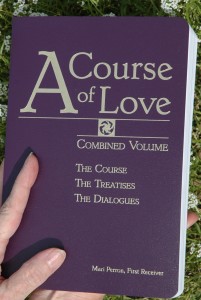 Ah, imagine now what it will be like to have nothing left to learn, nothing left to become. The pressure is off. The alchemy has occurred. The coal has become a diamond. Ah, imagine now being able to forget all ideas of self-improvement, imagine how much time will be saved by this quest coming to an end. E.1
Ah, imagine now what it will be like to have nothing left to learn, nothing left to become. The pressure is off. The alchemy has occurred. The coal has become a diamond. Ah, imagine now being able to forget all ideas of self-improvement, imagine how much time will be saved by this quest coming to an end. E.1
I ask you but to give yourself a chance to forget about approaching this as one more self-improvement exercise, or one more objective to accomplish. Only in this way do you come to realize you are already accomplished. A.12
There are two ways to search a word like “rest.” One is with the Concordance. Here, you click on the letter “R” and find all the words in the Course that begin with this letter. Scrolling down to “rest” you see that there are 83 occurrences of the word in ACOL. An additional way is to click on the blue phrase Search for Word or Phrase in A Course of Love. When you do so, there appears a box in which you can type your word (or phrase). In typing “rest,” variations, such as restful, resting, and restless also appear. They appear, as in the Concordance, in context. But with the Search Facility, you can also click on the reference at the left (also in blue) to view the entire paragraph, as well as future and next paragraphs. You can also copy and paste as I have, but here’s a hint for doing so: For the sake of formatting, do not copy with the reference. Copy the text only and add the reference manually.
Today I wish you “rest,” along with happy arising, searching, finding and enhancing ~

Memories and dialogue and new memories
You can respond to love with love. D:7.10
 I so wish I had been walking each morning of this lovely long fall. I walked today. It was just about 7:00, I suppose, that I went around the horn. It was almost light, but not quite, the sky sitting close, keeping her eye on the street. The street keeping an eye on the children. The sense of a benevolent eye, a friendly watcher of the neighborhood, the presence of a kind of care. Straight away, the man who smokes in his neat garage gave me a friendly wave. Around the corner, the house with the fire pit, lined up with bench, chair and toddler’s chair sat still and quiet. Then Charlie, Freddie, Ruby and Adelaide, out with their mom in front of a big truck that from a distance worried me that they were moving. Closer, the sense that their mom, who home schools, was holding a lesson there on the street as they looked into the vast holding space—who knows, perhaps also awaiting some bit of furniture to be unloaded, but at the same time getting a “life” lesson. Continuing on, the memory arising of my dad pulling up in the alley in his truck and treating us “neighborhood” kids to a ride on the lift.
I so wish I had been walking each morning of this lovely long fall. I walked today. It was just about 7:00, I suppose, that I went around the horn. It was almost light, but not quite, the sky sitting close, keeping her eye on the street. The street keeping an eye on the children. The sense of a benevolent eye, a friendly watcher of the neighborhood, the presence of a kind of care. Straight away, the man who smokes in his neat garage gave me a friendly wave. Around the corner, the house with the fire pit, lined up with bench, chair and toddler’s chair sat still and quiet. Then Charlie, Freddie, Ruby and Adelaide, out with their mom in front of a big truck that from a distance worried me that they were moving. Closer, the sense that their mom, who home schools, was holding a lesson there on the street as they looked into the vast holding space—who knows, perhaps also awaiting some bit of furniture to be unloaded, but at the same time getting a “life” lesson. Continuing on, the memory arising of my dad pulling up in the alley in his truck and treating us “neighborhood” kids to a ride on the lift.
Back in the cabin it is still so damn beautiful! It’s a beauty different from the early days of color and sun. The trees wave their bare arms in light that never seems to arrive. Perfect memory weather. Fall and remembrances of fall get mixed together. The mornings when Mom would shove graham crackers spread with peanut butter and wrapped in a paper towel into my hand so that I would have “something in my stomach” after having been too late getting ready for school to eat breakfast. The sluggish and rushing quality of the start of it all, the change of seasons within a chain of seasons, school years, times of life, now.
and sun. The trees wave their bare arms in light that never seems to arrive. Perfect memory weather. Fall and remembrances of fall get mixed together. The mornings when Mom would shove graham crackers spread with peanut butter and wrapped in a paper towel into my hand so that I would have “something in my stomach” after having been too late getting ready for school to eat breakfast. The sluggish and rushing quality of the start of it all, the change of seasons within a chain of seasons, school years, times of life, now.
Then. Now.
An ode to reverie. To its melting of time. Farther back. Mom tying my kerchief or hood beneath my chin (how long it took me to gain that skill!) The way Dad hitched up his pants as he walked. The burning of fall leaves. The tarring and sanding of the road and the way it spit under the tires of my bike.
[M]emory allows relationship. Memory, or how you relate to past experiences, is what makes each individual unique. A family can share many similar experiences without relating to them in the same way. It is the way experience is related to, through memory, which shapes the different personalities, paths, and thus future experiences of each of you. T1:6.7
Even as I browse old memories as they arrive (don’t we only rarely go seeking them?) I’ve been making new memories with the conversations I’m having for the new Dialogue Series about to launch on the Center for A Course of Love website—“spoken” dialogues I’ll not only remember but get to share and to revisit. Although the idea initially arose from the thought of wanting to capture some memories of how A Course of Love began, I found so much more to cherish in the first of these that ACOL’s history became secondary to relishing and sharing the joy of dialogue.
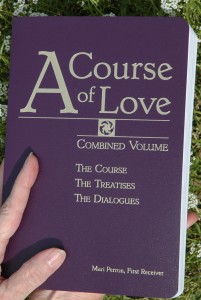 Jesus first mentions dialogue in “A Treatise on the Art of Thought.”
Jesus first mentions dialogue in “A Treatise on the Art of Thought.”
Creation is but a dialogue to which you have not responded. The art of thought will free you to respond. T1:2.12
We hear of dialogue alongside the practice of informing and being informed in Day 15. “What does this mean? It means to join together with others who have the ability to maintain Christ-consciousness in your company. This creates the joining together of spacious Selves. It is a joining without boundaries. You become clear pools flowing into each other. You make your spirits known.”
In 15.13 Jesus says that if you don’ feel ready to enter dialogue, examine what you fear: “Is it really the stones [as of regret] within your pool, or is it the challenge of moving with the current that you know will be generated by the joining of spacious Selves? Do you fear your power even though you have been told it cannot be misused? Do you feel unworthy and seek to keep your unworthiness hidden? Do you still fear being known?”
And then in 15.14: “If so, enter the dialogue with the purpose of your final preparations in mind. Bring your fears into the light of oneness and see how the light dispels the darkness.”
I would call reverie a dialogue with one’s self and one’s memories, a softening of the edges of the past, a preparation for the future and for the free-flow of life, love and dialogue.
I have now completed six dialogues. Each one is so incredibly unique. So personal. So universal. They remind me, and perhaps will remind you, that when we speak Christ-self to Christ-self, we still look like ourselves, sound like ourselves, also are our Selves. Both/and. The beloved and the accomplished no matter what. No need to fear (not even sharing what we fear!). Being who we are is so beautiful!
Realize that this is a call to love all of yourself. You who once could love spirit or mind, mind or body—because of the dualistic nature associated with them—now can love all of your Self, all of God, all of creation. You can respond to love with love. D:7.10
Watch for the link to the new Center website and for the first two of these video dialogues to be shared this week. With luck the site will “be live” by Thanksgiving and I’ll skip my Sunday routine forward and post amidst the slicing of apples and baking of pie, brimming with thankfulness for all those who share who they are with me.

Reminders of the need for unity
 In the worst of times, we feel our love arise and extend. We realize love cannot be defeated. In the worst of times we are united in love. And in the worst of times, we are reminded of the great need, of the urgency, to bring our awareness of who we are, and the loving acts we are capable of, to this world in need.
In the worst of times, we feel our love arise and extend. We realize love cannot be defeated. In the worst of times we are united in love. And in the worst of times, we are reminded of the great need, of the urgency, to bring our awareness of who we are, and the loving acts we are capable of, to this world in need.
We exist in unity. Starting out in “the Course” each of us hear that the only exercise for our mind is to “dedicate all thought to unity.” By the time we are in “The Dialogues,” unity is not only a thought of our minds: “As your mind and heart joined in unity and became capable of hearing the same language, you truly began to enter the place of unity.” (D.12.4) “We work now on your awareness and acceptance of your changed state, for without awareness the value of what we do here does remain minimal, and this I cannot allow. The urgent need for your return to unity has been mentioned before, and I remind you of this urgency again. ” (D.12.6)
In some instances, I like the words head and heart a little better than mind and heart. I like them because I can visualize this movement into our hearts, coming from the top down, moving, as Lars Gimstedt describes (in his book Jesus on the Elevated Self), back through all the chakras—back into our bodies, and our Earth. But our acceptance, as Jesus so kindly acknowledges, may not always match our inner knowing and allow our awareness to grow. And so the time for this last step—of accepting and acknowledging, of coming to awareness of our true state of being—is here. It is here, and moving into you and me, into life, and into the world.
All of this is going on now. It is happening in us at the same time that acts of terrorism and war are occurring. In this month, when remembrance of war is nearly constant, it is a particularly poignant and appropriate time to practice our awareness of unity.
Veterans Day in the US and Remembrance Day in other countries, remind us now of former ways of waging war. Nine million military personnel died in World War I. The WWII Foundation estimates a high figure of 80 million deaths from that war when including war-related disease and famine. The total military dead: 21-25 million, including deaths in captivity of 5 million prisoners of war.
In this century, the feeling that everything is changing, including ways of waging war, is keenly evident. On the one hand we have war waged in a way that feels like virtual reality (drones for example). In another, we have terrorism, which is dominated by rage and hate and who’s most devastating characteristic is its element of surprise. You wonder how such acts can be prepared for or responded to. You may wonder, Where can I be safe? You may wonder, What place has 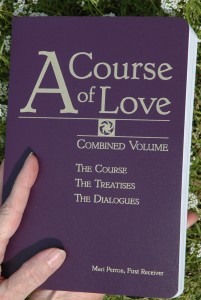 love?
love?
In the worst of times, we realize that love cannot be defeated. Everything is changing. As we realize our unity with all, and as our love in-forms and descends deeply into us and deep into this earthly realm, we can become aware of the reality of unity, and truly know ourselves as carriers of the power of love. Love is the only power capable of changing the world.
As Jesus says, “So be it.”


